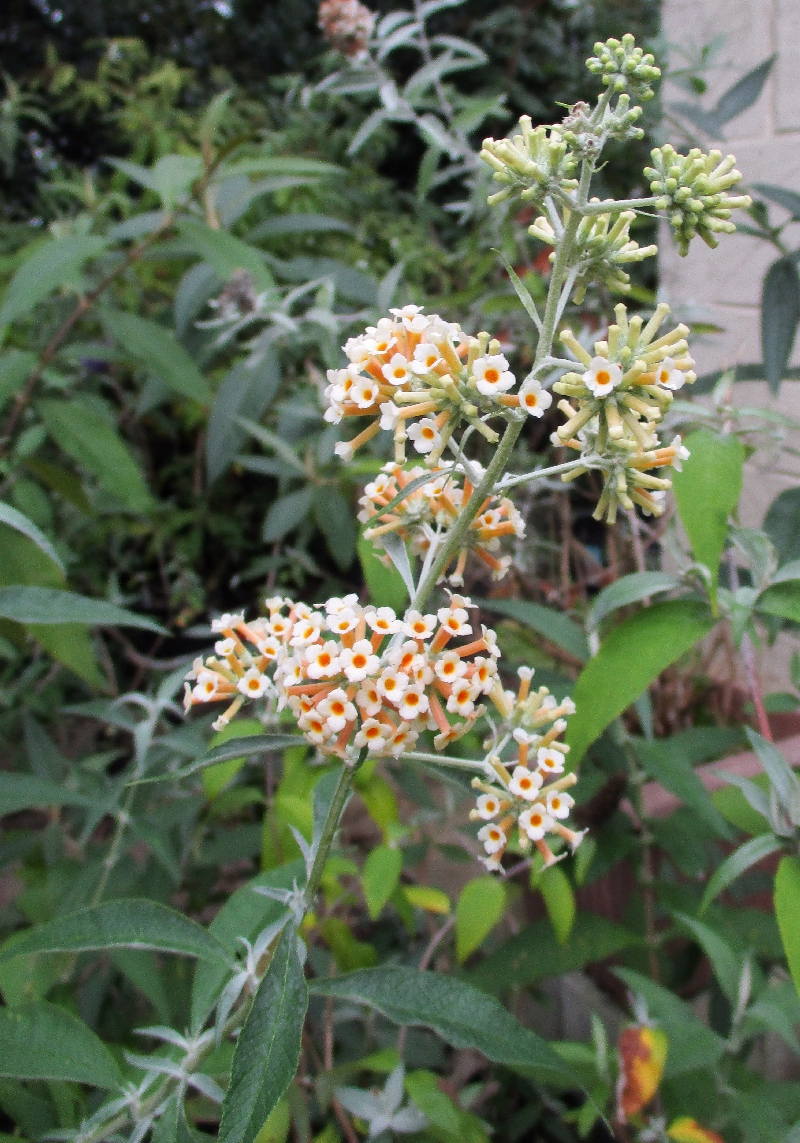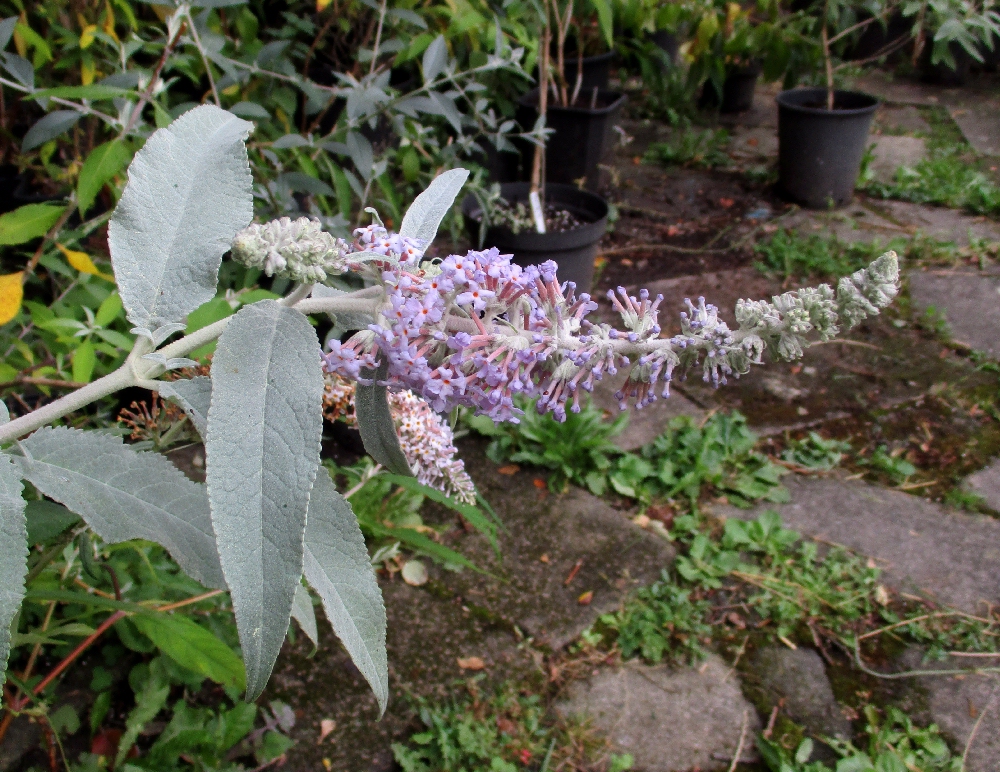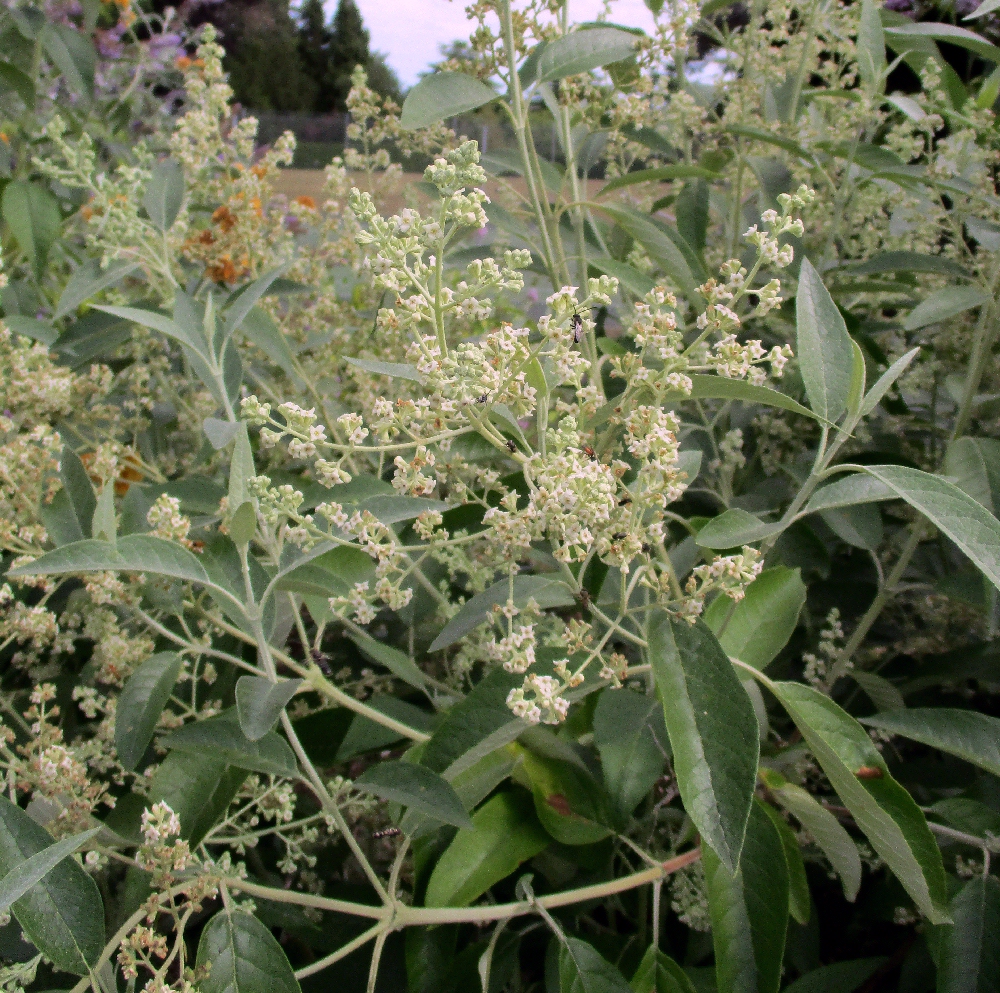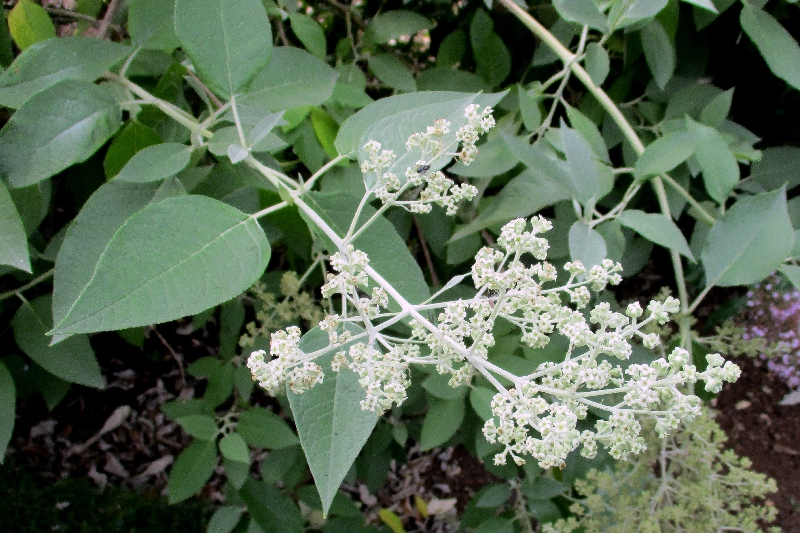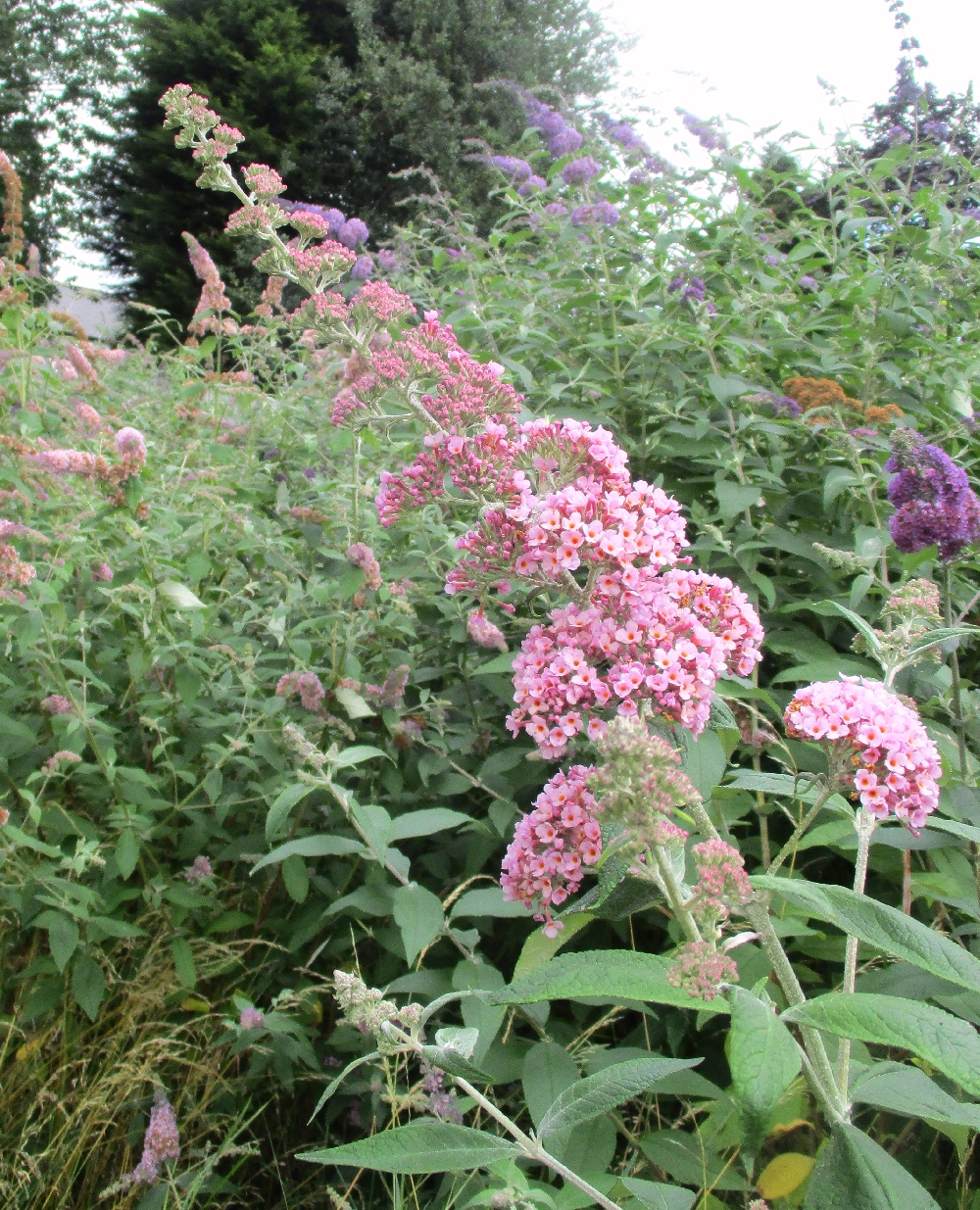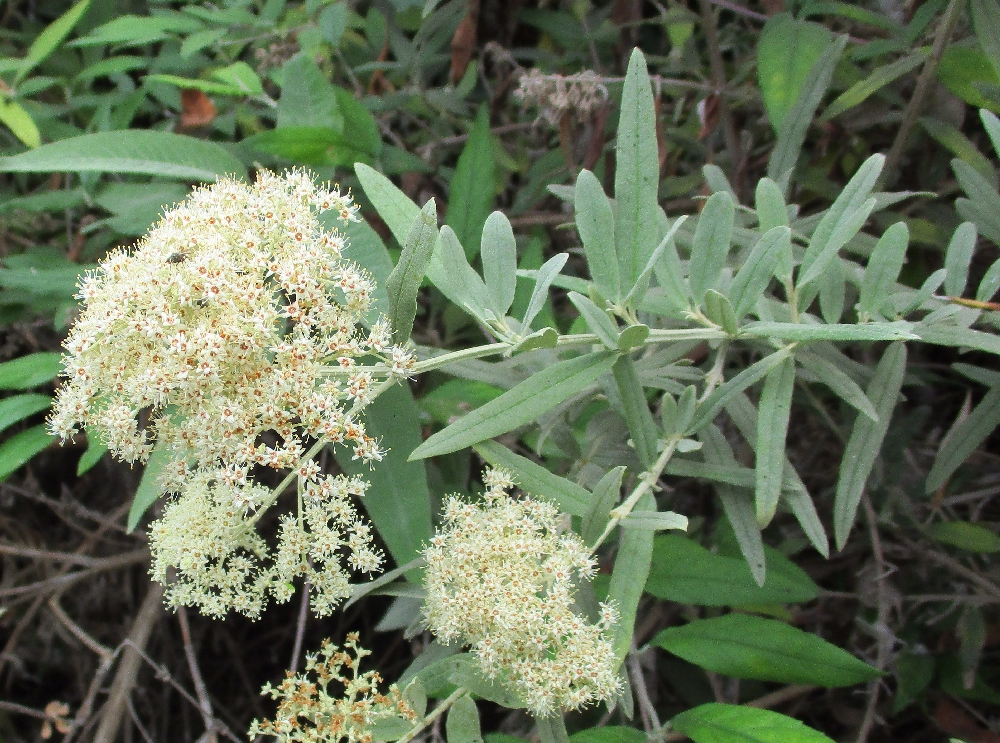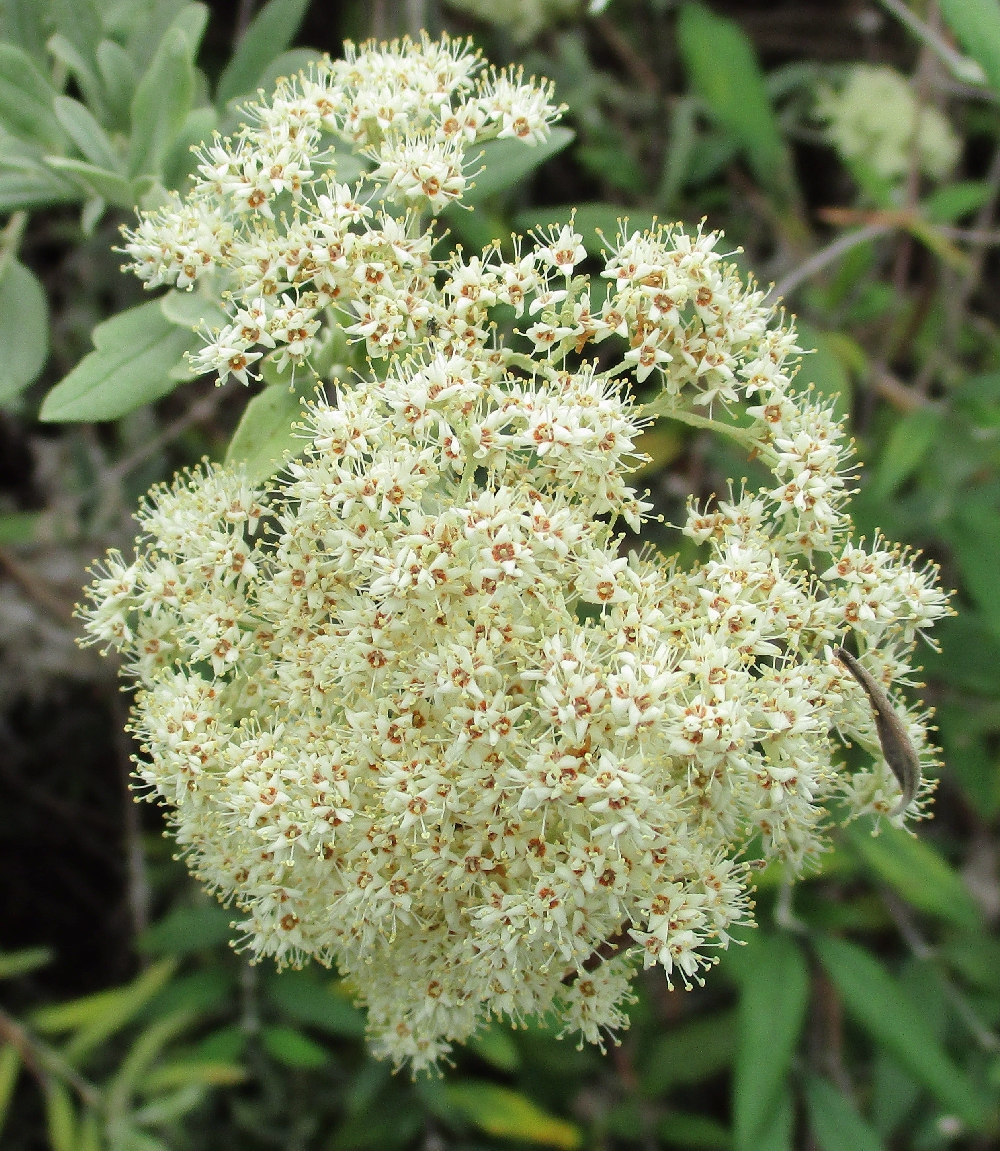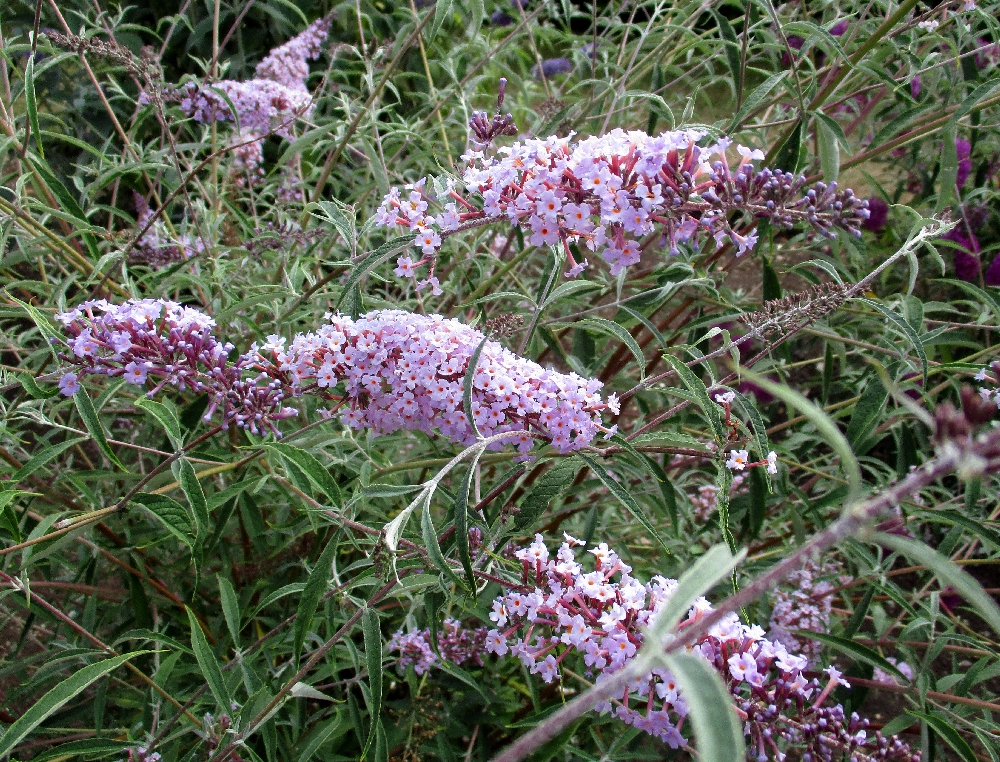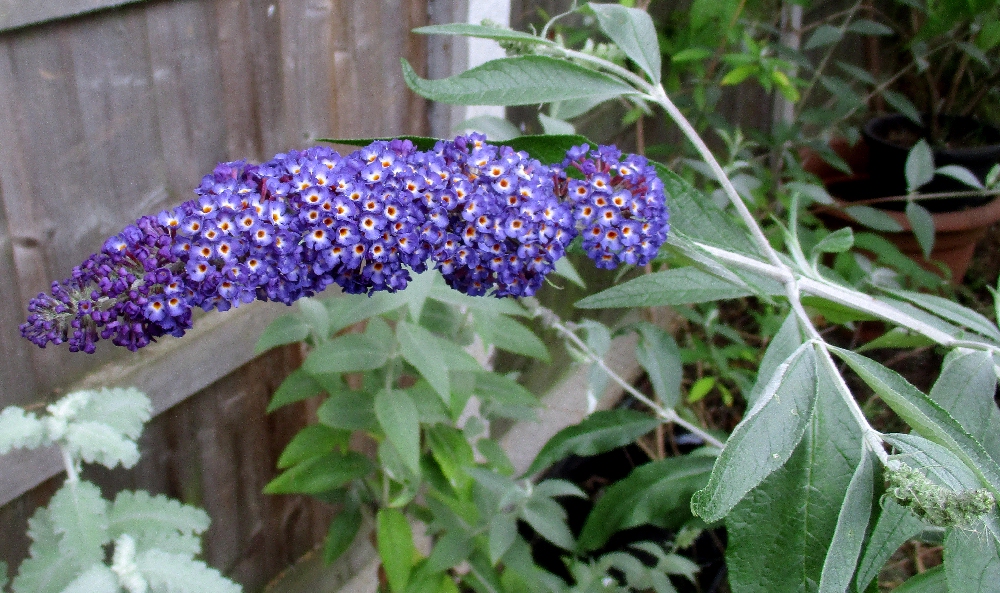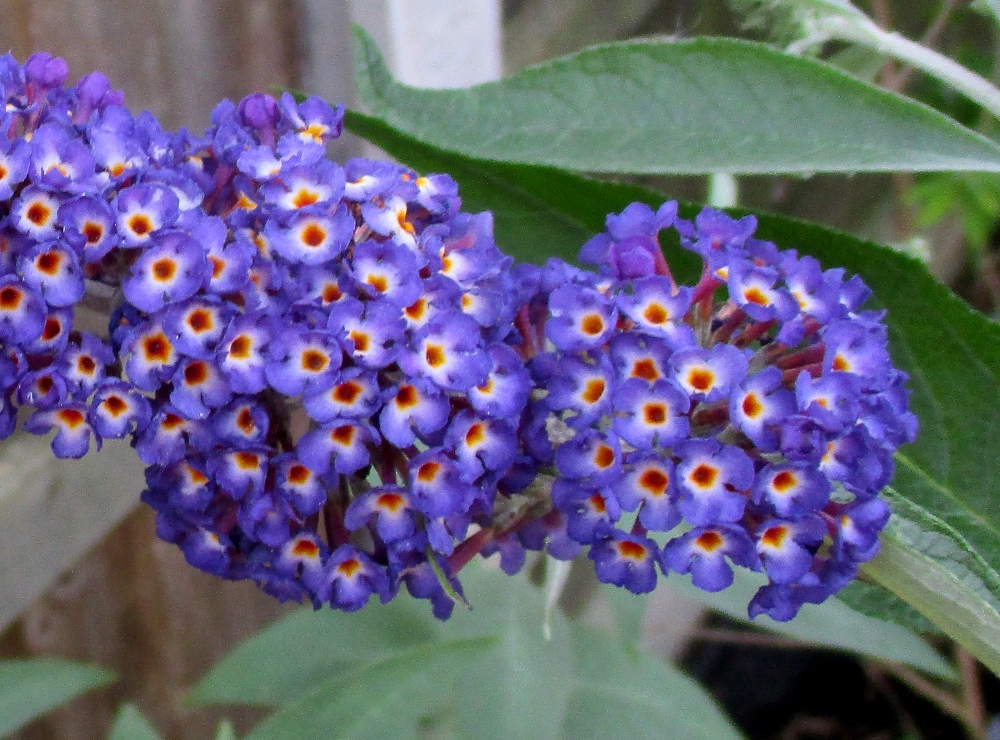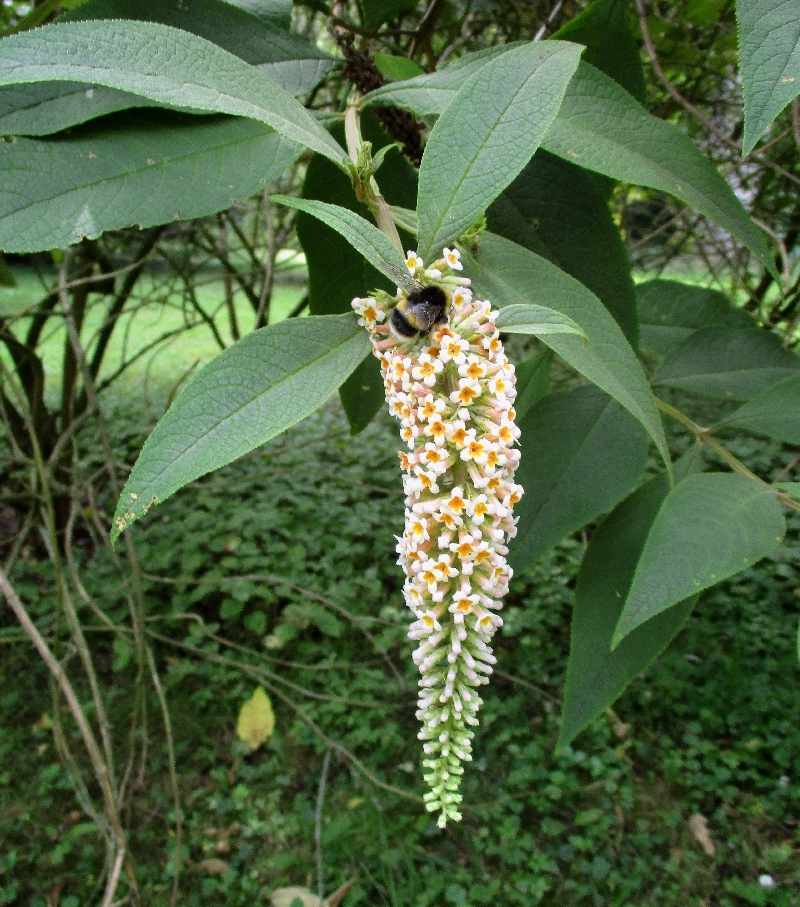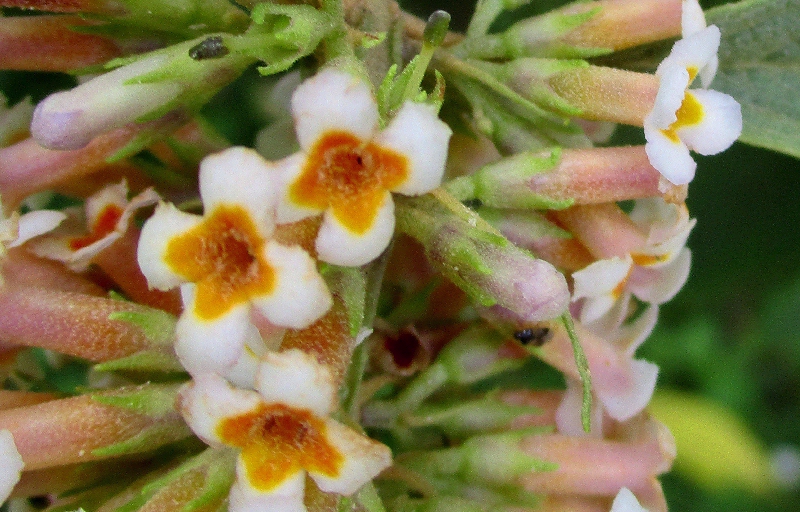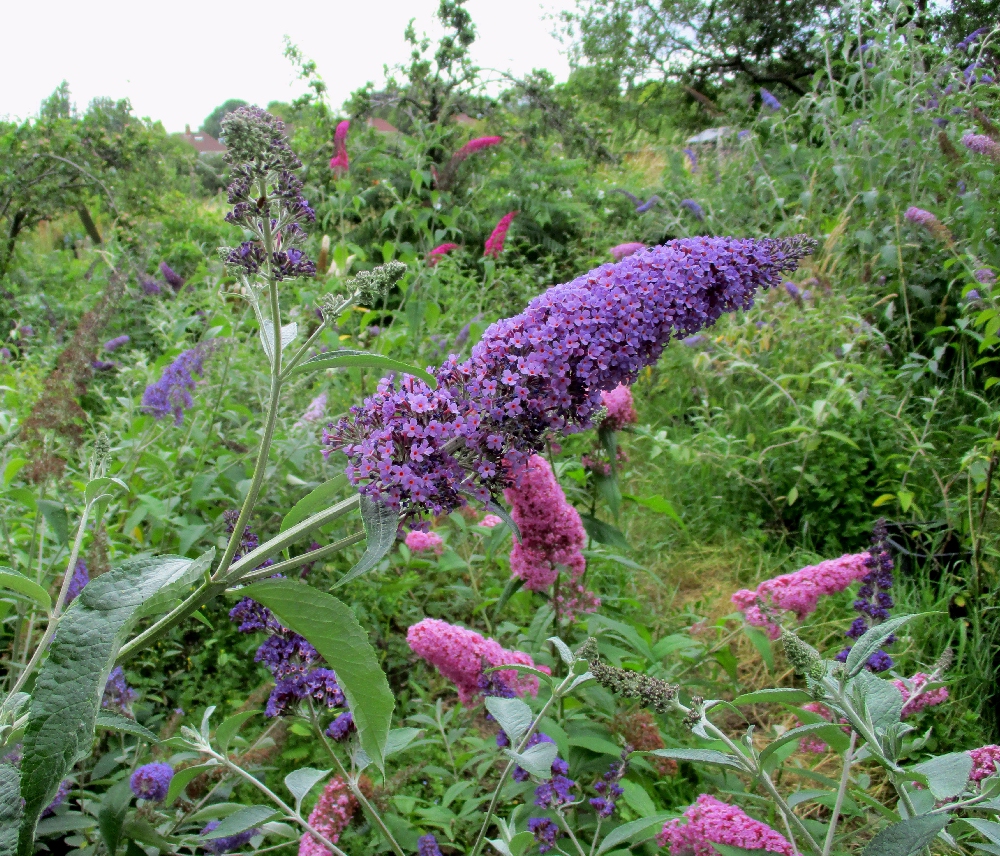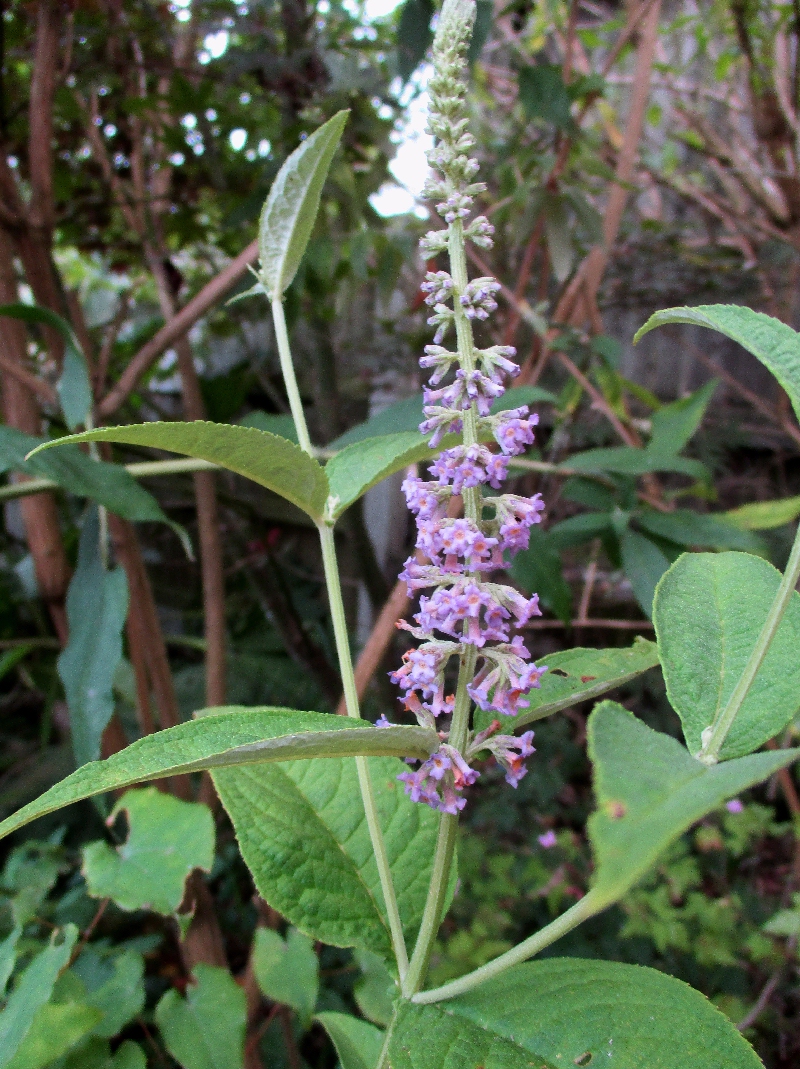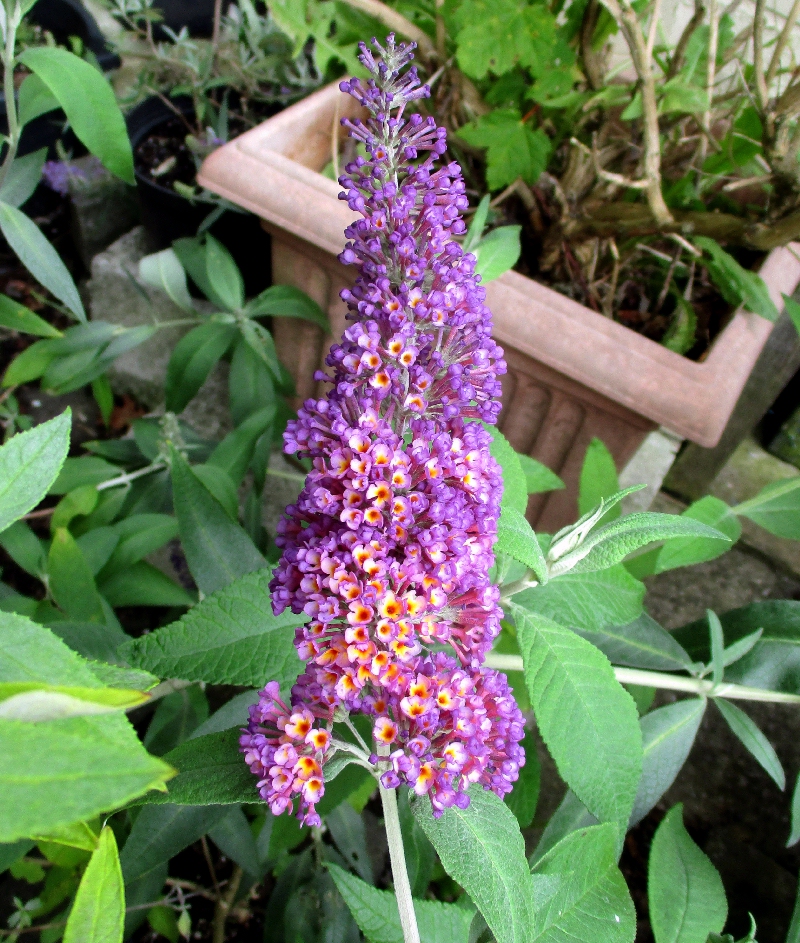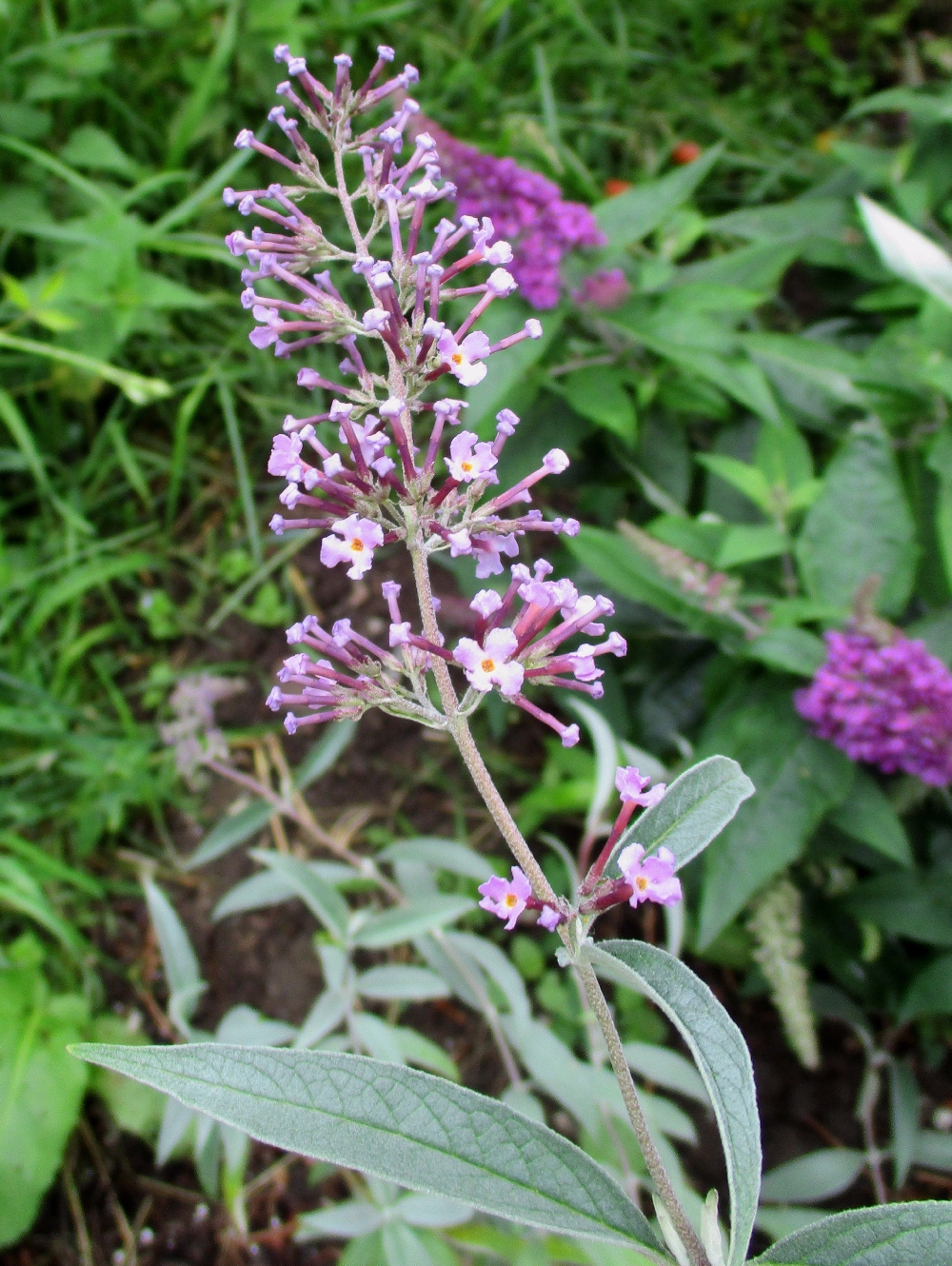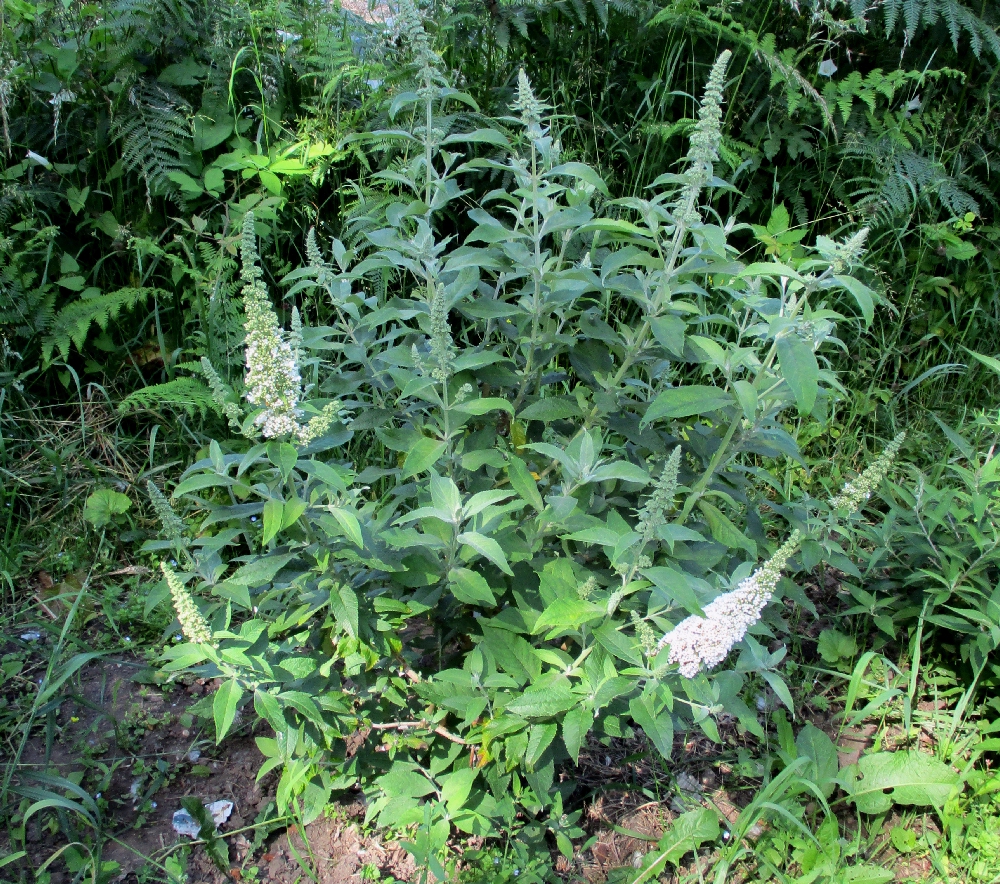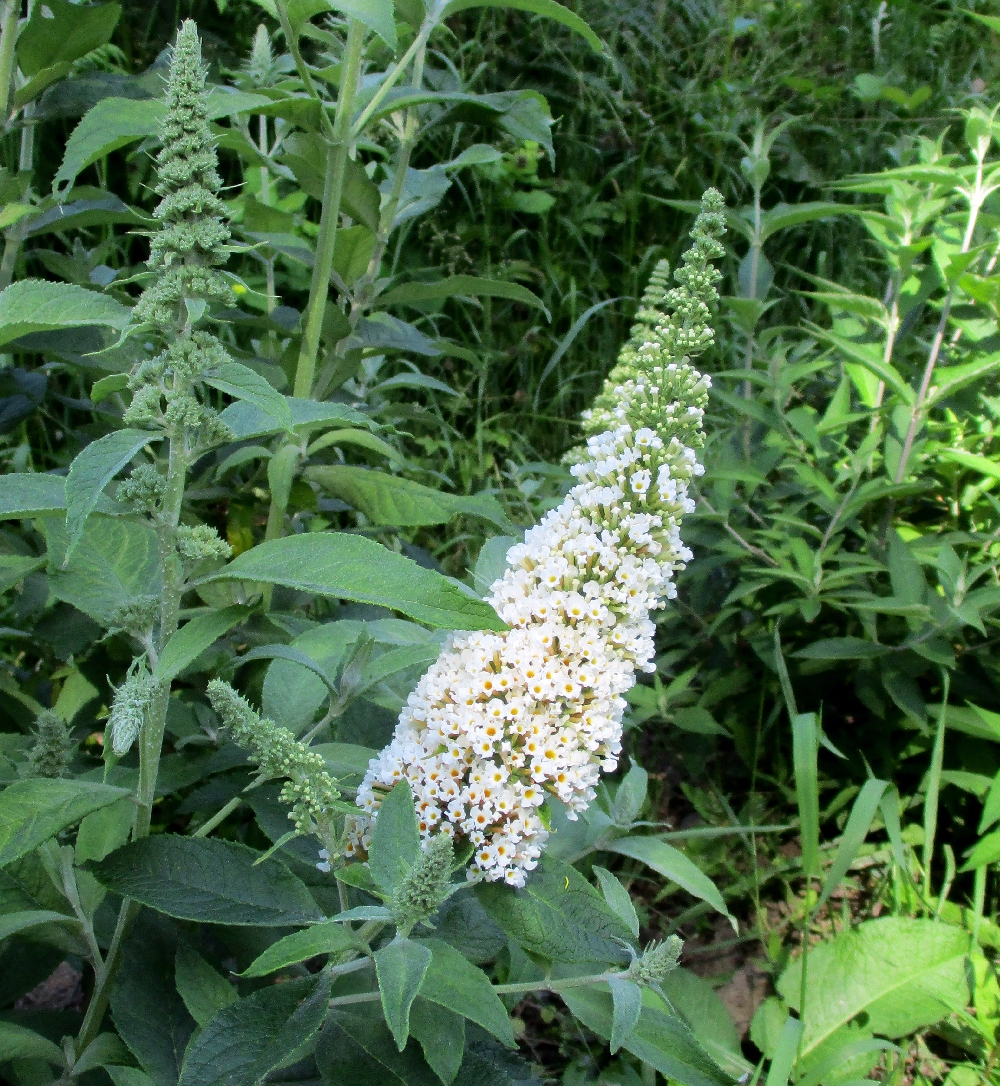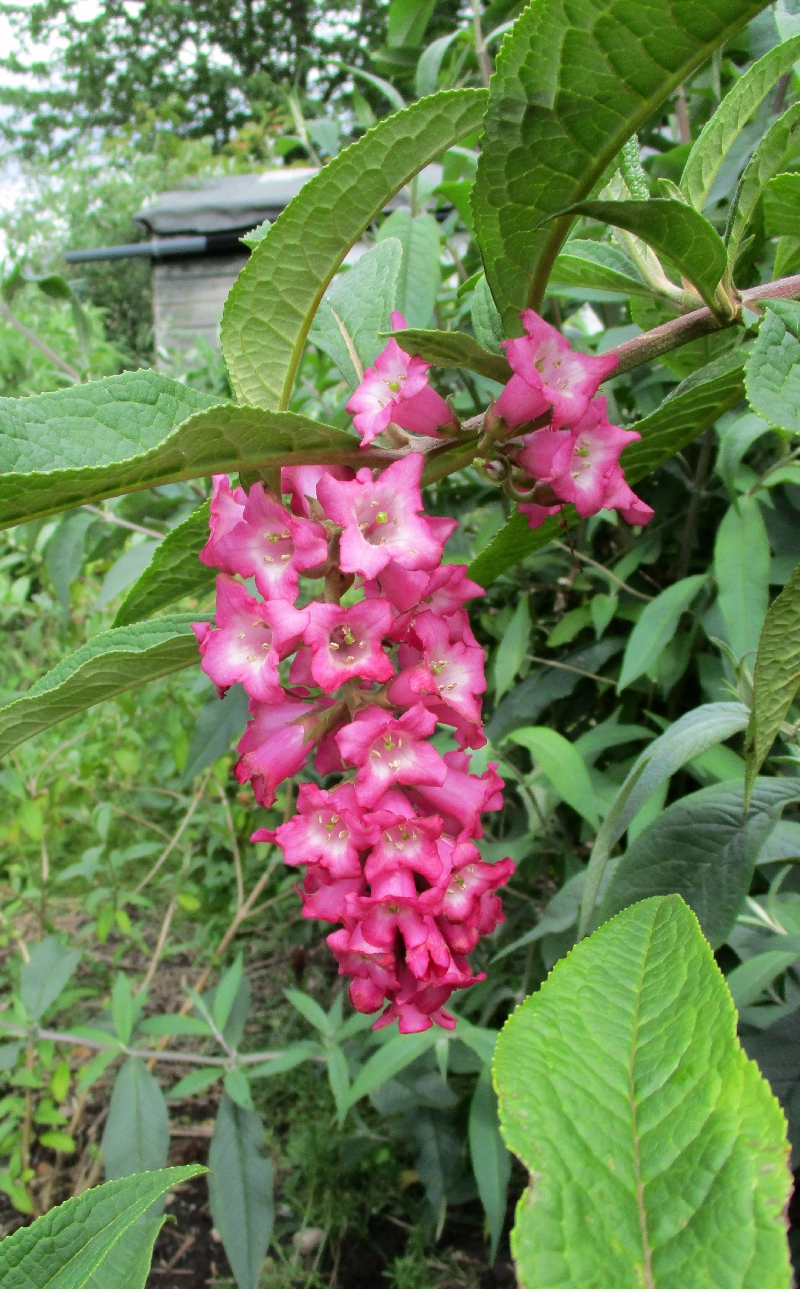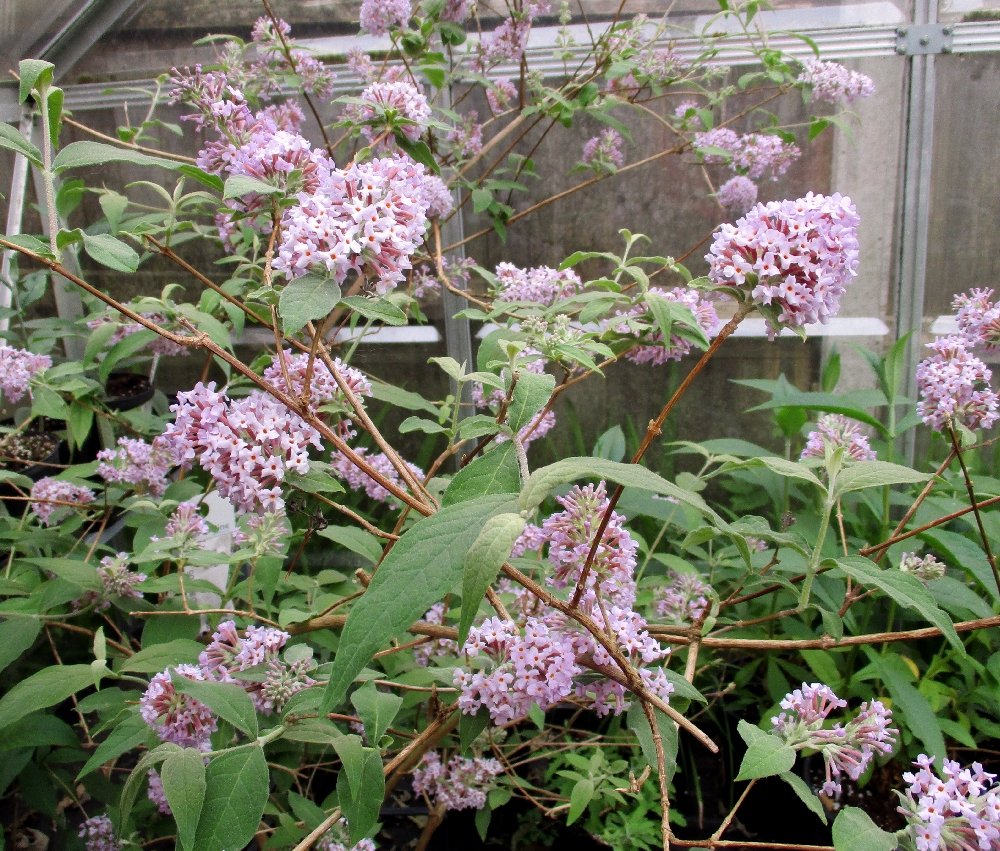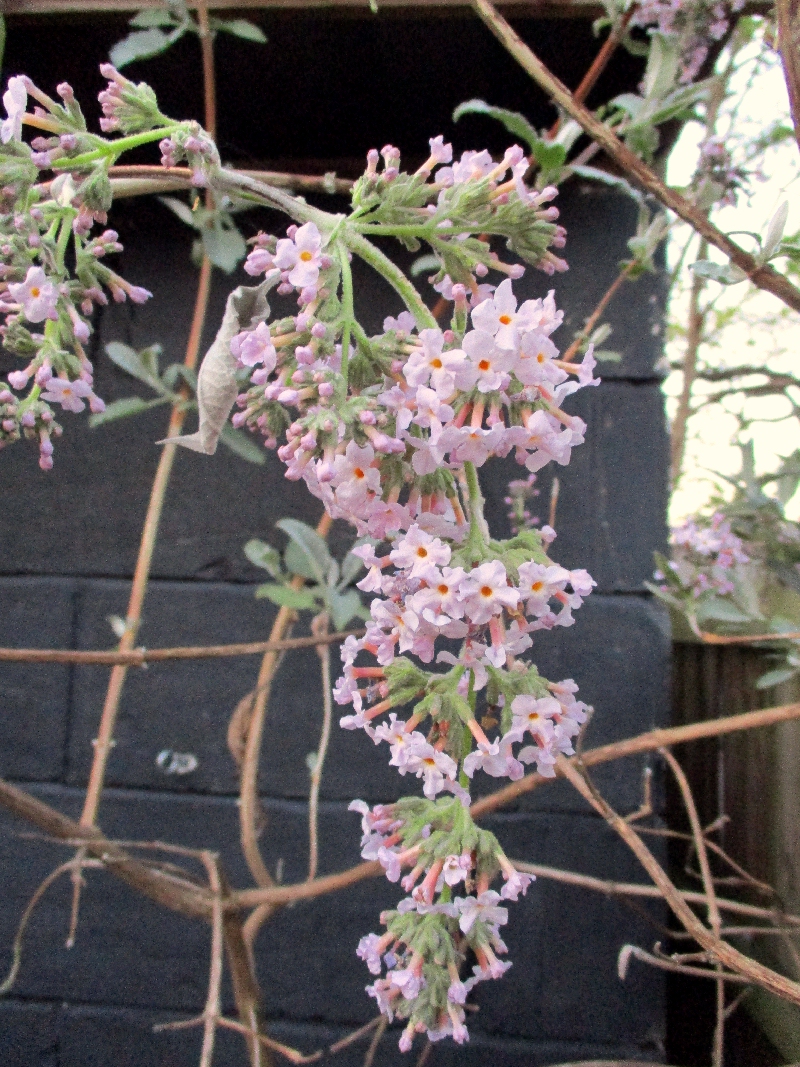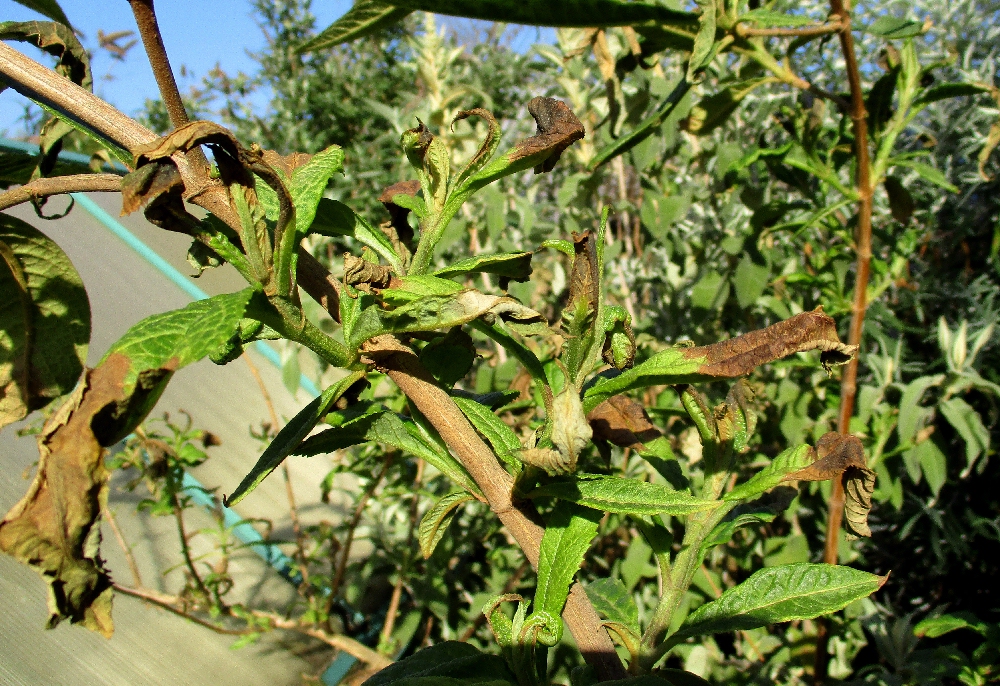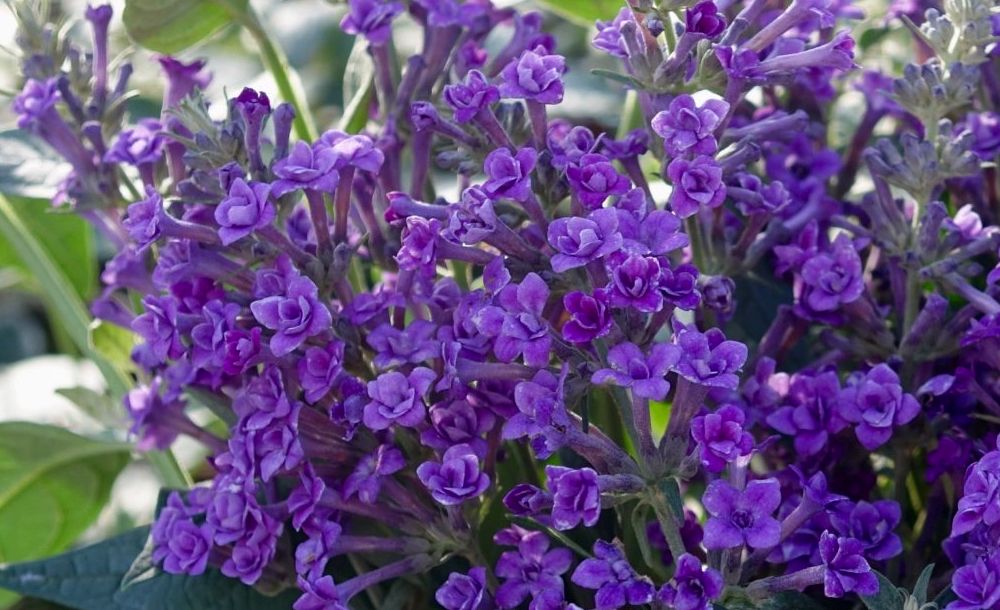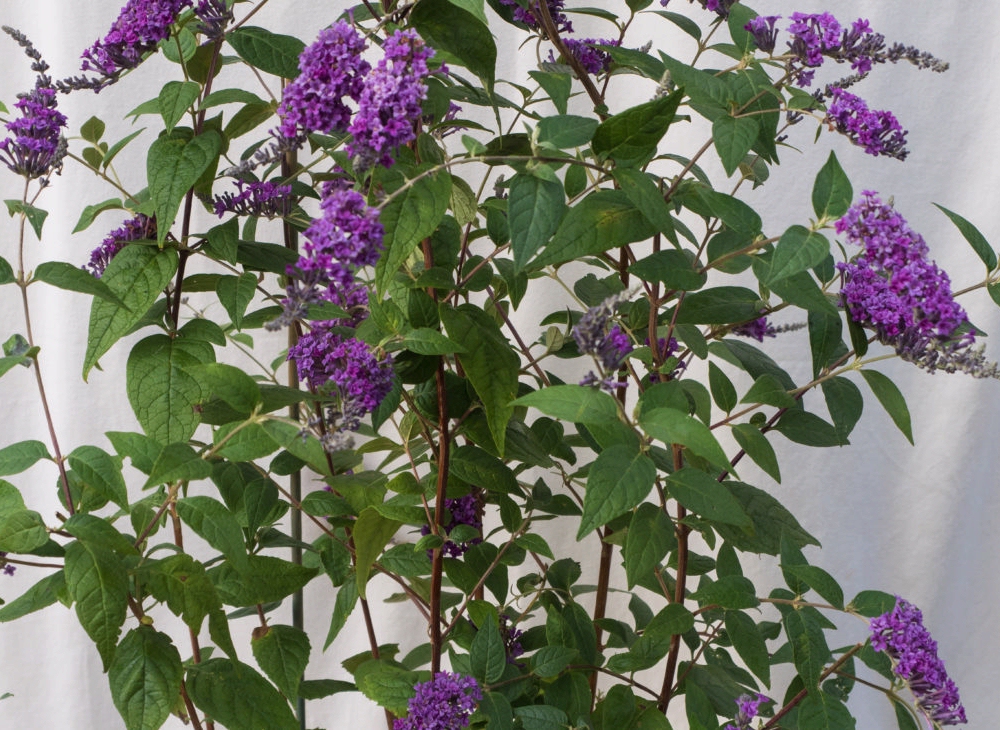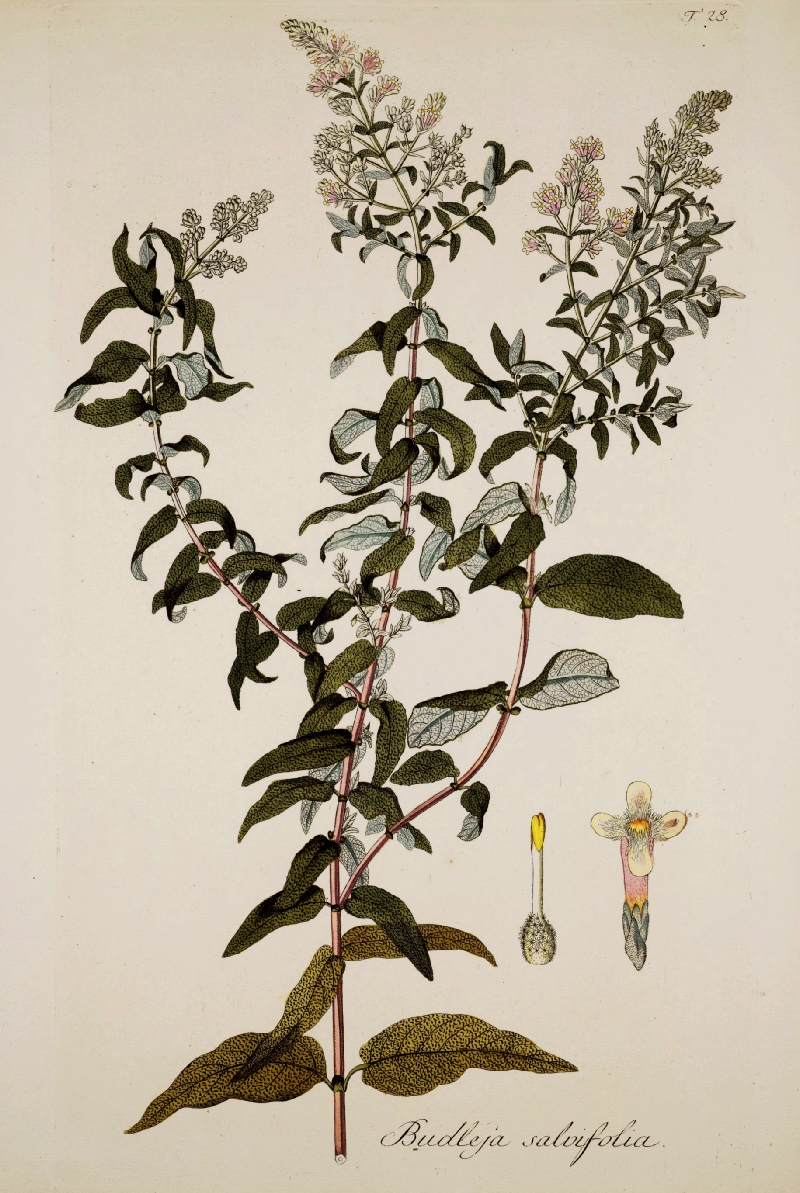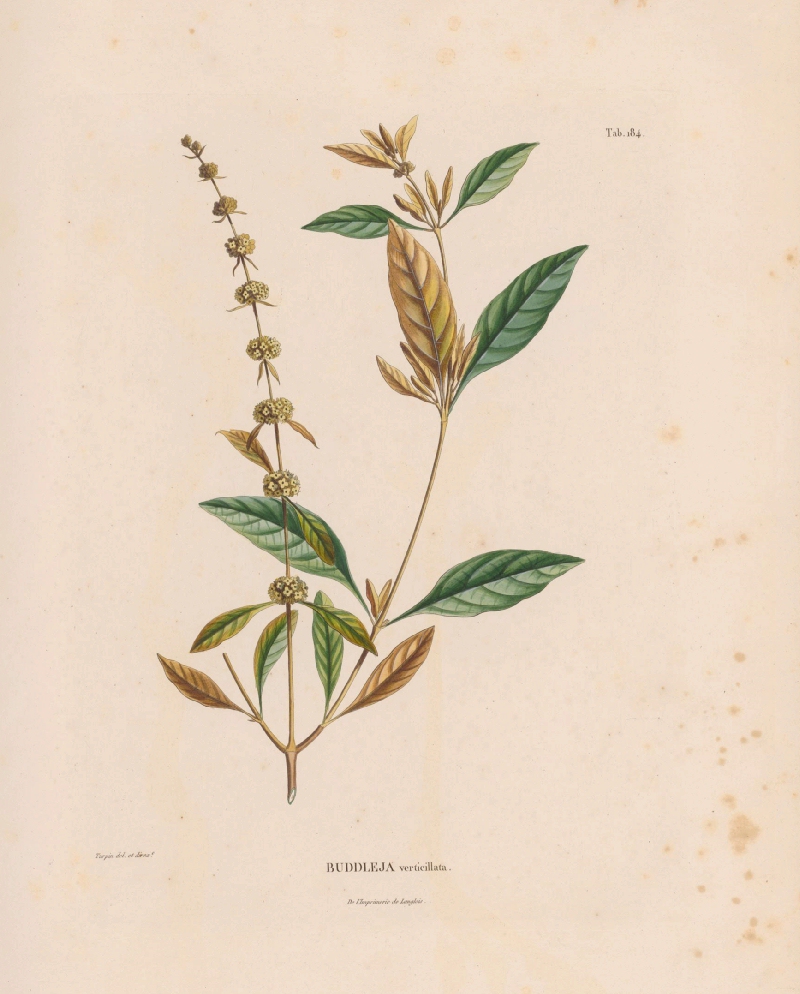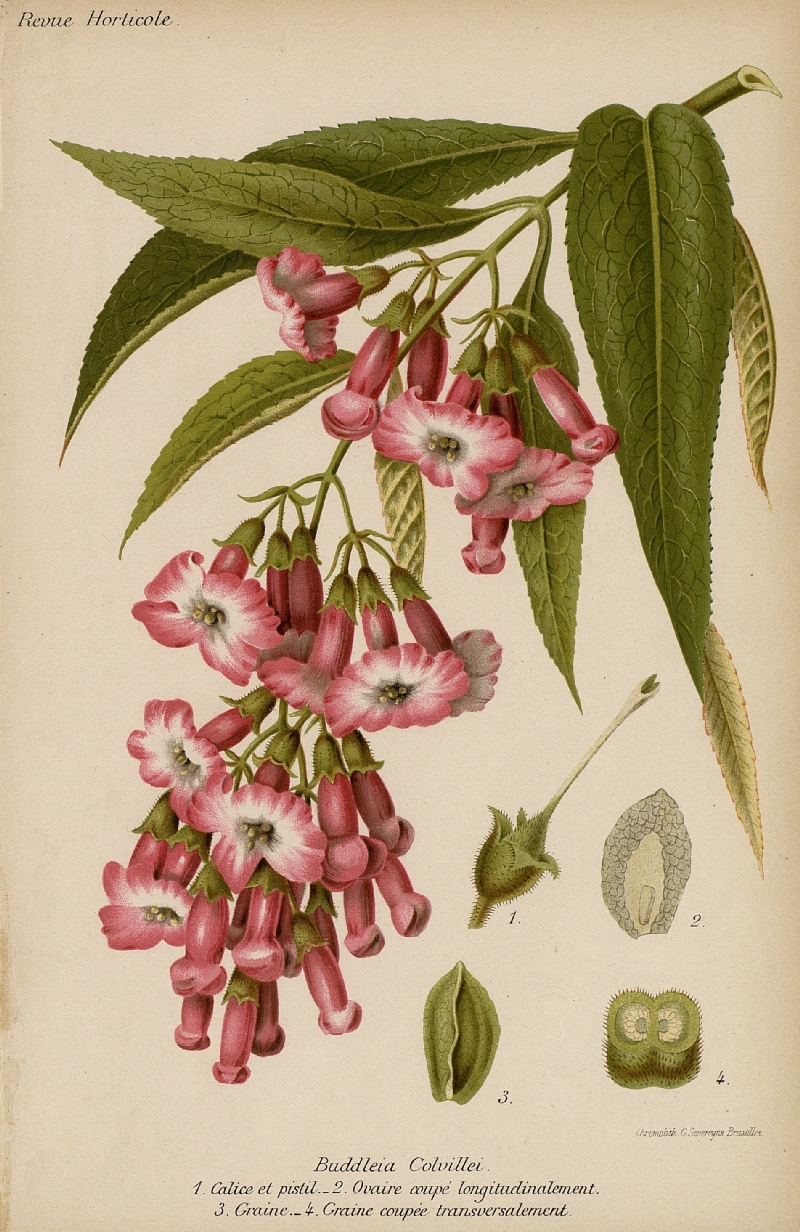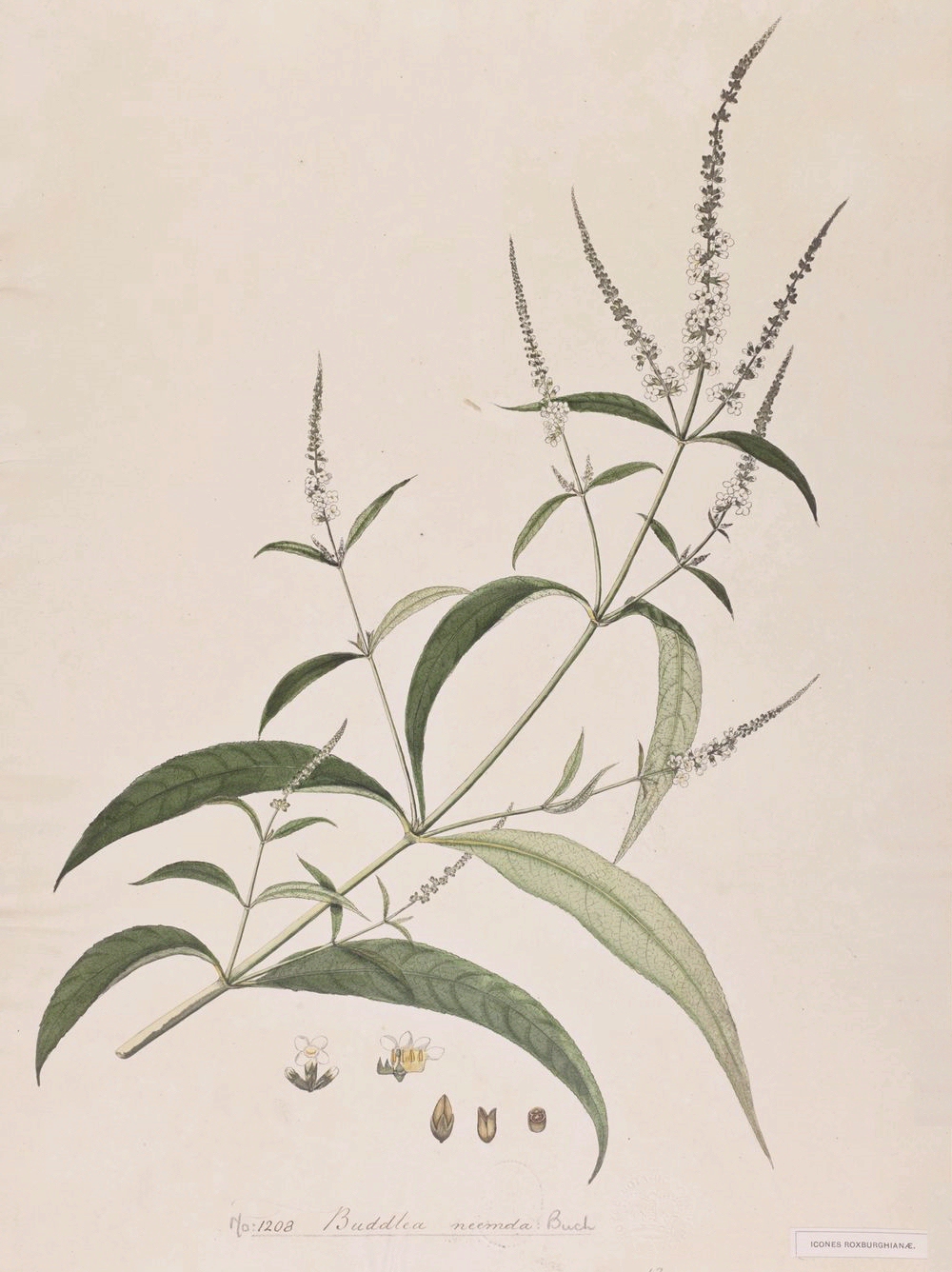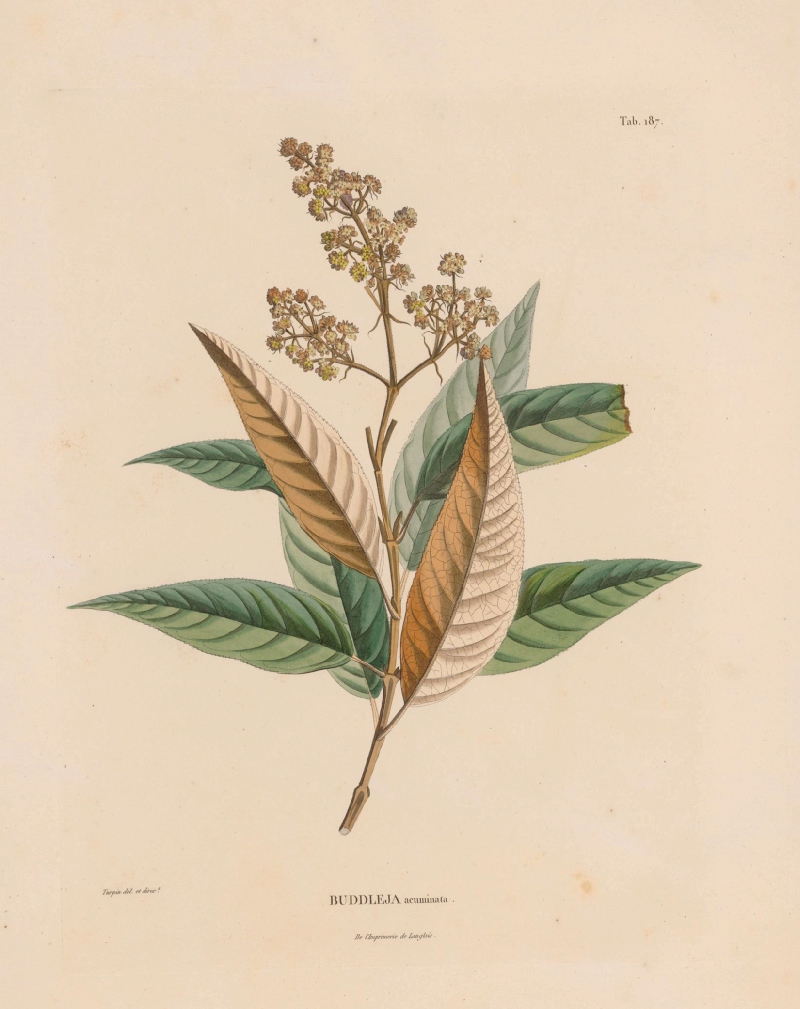
 | |
Click images to enlarge | |
F1 HYBRID of
| |
| | |
Buddleja fallowiana
| |
|
| |
Buddleja cordata2nd September 2019There is a limit to how many Buddlejas I can grow, and one I've missed out on is Buddleja cordata, usually divided into three distinct subspecies. From the central Mexican highlands, it's the Buddleja with the potential to grow the biggest. In its native forests, specimens of 30 metres or more can be found – a Buddleja tree. Although hardy in most of the southern UK, the species is unlikely to ever reach these proportions here, remaining a shrub if pruned or becoming only a very modest tree if not. On a recent visit to the Longstock Nursery, I was able to examine and photograph this species in flower. The Longstock collection has two specimens: one labelled B. cordata subspecies tomentella and B. cordata, no subspecies recorded. Both have been kept pruned to control their size and I believe both are female (B. cordata is dioecious). Using the key from Eliane Norman's Buddlejaceć (Flora Neotropica Monograph 51, 2000), I believe the second plant to be subspec. tomentella as well, being unlike the descriptions of either subspec. ovandensis or subspec. cordata, the latter being distinguished by its golden-yellow flowers. The upper photograph shows B. cordata, subspecies tomentella. and the he lower photo is B. cordata, the subspecies unrecorded. The second has the more typical heart-shaped leaves from which the species gets its name. Otherwise they are alike, with large sprays of white flowers (subspec. ovandensis has smaller inflorescences). A close up of the flowers shows how each individual tiny flower (or floret) is similar to other South and Central American species. | |
|
| |
Buddleja Flutterby Peach Cobbler15th August 2019The Flutterby series of Buddlejas were bred in America a few years ago by Peter Podaras. There were about fifteen hybrids of various sizes and growth habits; for Europe the small ones were renamed “Free Petite”. The larger hybrids, the Flutterby Grande™ cultivars, were never brought over. A couple, Sweet Marmalade and Tangerine Dream, are hybrids of B. marrubiifolia and have unusual orange flowers, although I suspect neither would survive the UK climate. I have been able to obtain one Flutterby Grande™: Peach Cobbler (Podaras#5), shown in the photo opposite. Flutterby Peach Cobbler shares the same parents (Pink Delight and B. x weyeriana Sungold) as Peter Moore's Pink Pagoda (syn: Inspired Pink). And Peach Cobbler is very similar indeed, except perhaps a little less vigorous, and the flowers shorter and slightly fatter. Both are a very clear and clean pink; Peach Cobbler is certainly not at all peachy in colour, which is a shame as that would make it more distinct from Pink Pagoda. | |
|
| |
Buddleja saligna11th August 2019Buddleja saligna comes from South Africa where it has a wide distribution, growing by rocky outcrops and on mountain plateaux to an altitude of at least 2000 metres. Adaptation to high altitude means it is hardy in the UK, at least in the south of the country. Alternative names include the False Olive and the Bastard Olive, a reference to the narrow grey foliage that resembles an olive tree. And, like the olive, it grows into a small irregular tree with furrowed bark. However, the latin epthet “saligna” (pronounced sal-lig-na, the g is not silent) describes the features as being more like the willow (Salix). The inflorescences appear in August and are fluffy white cymes made up of hundreds of tiny flowers. On closer examination, they're quite Buddleja-like except for the exerted anthers: they stick out of the flower on long stalks or filaments. In the past, it had been included in a separate genus as Chilianthus olearaceus. This genus also included the other closely-related South African Buddlejas: B. glomerata (as Chilianthus lobulatus), B. loricata (as C. corrugatus), and B. dysophylla (as C. dysophyllus). All these species were also once erroneously placed in Nuxia, an African genus of elder-like shrubs unrelated to the common elder or Buddleja. Buddleja saligna and its close relatives weren't originally recognised as Buddleja, mainly because the aforementioned exerted anthers are so unlike the rest of the genus, where the sessile or near-sessile anthers (i.e.: with absent or very short filaments) are in the throat of the flower or within the corolla tube itself. (Photo taken at The Lavender Garden.) | |
|
| |
Buddleja davidii
| |
|
| |
The Orpheus Effect4th August 2019Below (25th July), I described a chance seedling of B. davidii with a yellow centre extending out into the petals. It's not quite what I was trying to obtain and came in a batch of seedlings where I expected white rings around the normal golden-orange throat of the flowers. The first named cultivar that had a defined white “eye” was Orpheus from The Lavender Garden. Subsequently, a number of new plants have appeared with what could be called The Orpheus Effect, a white ring around the centre. After several rounds of crossings and out-crossing, I have finally obtained a more strikingly defined eye in a rich navy-blue flower. The colour is deeper than in any previous cultivar and the eye large and precise. I've had any number of failures or near misses: failures where the white eye is either absent, diffuse or irregular; near misses where the main flower colour is wishy-washy, the eye no larger than the previous generation or the flowers panicles tiny. I'll probably keep going to see how far the effect can extend, although perhaps The Orpheus Effect isn't to everyone's taste. | |
|
| |
Buddleja macrostachya
| |
|
| |
Buddleja X
| |
|
| |
Would the Real Buddleja myriantha Please Stand Up27th July 2019I've mentioned before how most plants sold or labelled as Buddleja myriantha are usually something else, either B. curviflora or B.salviifolia. This has made me eager to track down a genuine specimen of the species in order to properly describe what B. myriantha should look like. So here it is, a bona fide specimen of the species from the Cangshan (Yunnan, China). Currently only a small cutting, this hardy species should grow quite fast and has already produced a small flower panicle. It's a unremarkable flower, purplish with very small florets. There is nothing terribly distinctive about this species: the leaves and stems are just like B. davidii and the flowers, with their shorter corolla tubes and hairy throats, are similar to darker variants of B.albiflora, except with B.myriantha the calyx and outside of the corolla tube are more tomentose (hairy), as can be seen in this close up of the flower. My thanks to Royal Botanic Garden Edinburgh for their help in sourcing the real thing.
| |
|
| |
Rhubarb and Custard, anyone?25th July 2019In keeping with Peter Moore's Berries and Cream, I'm presenting my cultivar Rhubarb and Custard… well, that's not actually its proper name yet. This new Buddleja, derived solely from B.davidii, is the result of several generations of trying to expand a white eye in the flowers, although in this seedling the eyes came out yellow. A closer look at the flowers shows how the yellow has spread from the centre out into the petals. It's a difficult effect to photograph. It's performing well now it's outside in the field and has come true from a round of cuttings. The yellow centres can fade a little in direct sun, but the effect remains quite striking. As with any new feature, the question arises as to whether it passes into the next generation. I'll tell you in a year or two. | |
|
| |
An Enigma from the Mountains of Sichuan24th July 2019This one is a bit of a mystery. It was grown from seed collected in Sichuan, on the southern slopes of Jiajinshan at an altitude of 2900m by Bjřrnar Olsen (BO-15-043). To my eyes the inflorescence looks very much like a weedy B. davidii panicle and the individual flowers conform to this common species with their long, thin, straight and glabrous corolla tubes. The actual plant is very small (less than a metre in height) and slight with grey foliage, and a habit quite unlike others of the species with the possible exception of B.davidii var. nanhoensis found in the neighbouring province of Gansu. I have more siblings which are more or less the same, so this isn't a one-off mutation. I have tentatively identified it as a small, high altitude variant of B. davidii, although collected from outside of this species' normal range. It's definitely not one of the smaller species – B. brachysyachya, B. yunnanensis, B. microstachya – found in the Chinese Himalayas. I very much doubt it's a new species to science, most likely it's an unexpected example of B.davidii var. nanhoensis from the mountains of Sichuan. | |
|
| |
Small and White11th July 2019I've had endless trouble with many of the new “dwarf” cultivars from the USA. New ones appear every year, whilst older ones just disappear, and it seems a case of something new for the sake of novelty rather than any improvement in garden performance. Some can't take the English climate and rot off in the ground, some are insect-damage prone, some flower much too late in the season, some are hopelessly lax in growth habit, and some just fall over with the slightest breeze. You can add to that list the fact they are advertised as sterile when they are in fact often very fertile. It's easy to raise a delicate hothouse flower in a pot to produce enticing publicity photos or for a garden centre display; it's another thing to breed a plant that does well in a real garden. So, all in all, they're not my favourite Buddlejas. But I couldn't help but keep seeds back and see what they produce. Most of the seedlings were terrible: plain lilac or lavender, bad growth habits or disease prone. However, one stood out. The seedling shown has remained at less than a metre high, has a dense well-branched habit with good foliage, and large upright white flowers. And, as attested to by the surrounding weeds, it is performing in a real situation on an open site in the Midlands of England. Best of all, the scent is something I've never encountered before in a Buddleja: it smells just like a rose! Sometimes plants are exceptional one year only to disappoint the next; it takes several years for a Buddleja seedling to fully mature and show its true form – something not always appreciated by the horticultural companies. So I'll wait until next year to give it a name… if it continues to perform well. | |
|
| |
Old Cultivars12th June 2019This pink-form of Buddleja colvilei has flowered well this year, much bigger inflorescences probably being due to finally being planted in the ground rather than in a large pot. A mild winter meant it kept its leaves and has established well. I have no idea of its origins. I've recently come across the Nagoya Protocol on Access to Genetic Resources and the Fair and Equitable Sharing of Benefits Arising from their Utilisation to the Convention on Biological Diversity. The UK and EU are fully signed up to the convention: see The Nagoya Protocol (Compliance) Regulations 2015. I won't go into great detail, but this addition to Convention on Biological Diversity (1993) applies particularly to any material (including seeds) collected form the wild after October 12th 2014. The onus is on the collection holder (such as curators of botanical gardens) to keep accurate records on the origins of their plants, and to ensure any material was collected in accordance with the laws of the relevant country. It also restricts their use in plant breeding or commercialisation in horticulture unless there is an agreement with the country of origin on the sharing of benefits arising from their utilisation. What of plants like the one shown? Well, it could've come from any of four different countries and has been in the trade for decades. And its collection certainly predates both the Nagoya Protocol and the Convention on Biological Diversity. The protocol will not be retroactive and long-established garden plants are unlikely to affected. | |
|
| |
Buddleja heliophila…24th May 2019There is a large group of Himalayan Buddleja which flower in the spring. Mostly, the flower-buds form the previous autumn and sit dormant through the winter. Many will have their buds damaged or even destroyed by hard frosts or bitter winds; so even where the plant is hardy, it may rarely flower well. One such plant is Buddleja heliophila (more correctly called B.delavayi, but still usually labelled with its former name), a plant I grow in a large pot so I can shelter it over the winter. It has bloomed quite late this year, end of May, and has put on a spectacular show, flowering as it comes back into leaf. What's more, it's highly perfumed with a scent difficult describe and quite unlike any other Buddleja. | |
|
| |
A Changeable April26th April 2019Buddleja agathosma was once a species in its own right, but now is considered only as a form of B.crispa. Whilst different from the summer-flowering type, it is similar in most respects to the other spring-flowering types, such as B.sterniana and B.farreri (see The Buddleja Crispa Complex). The deciduous B.agathosma holds its dormant flower buds all winter on bare stems, which burst into life when the weather starts to warm, usually in April for most of the UK. Just after the buds begin opening, the bare stems start to shoot with new growth. This winter has been mostly mild and so B.agathosma has flowered particularly well, having lost no flowers buds to persistent hard frosts, snow or freezing winds. The frothy lilac-pink flowers (see top photo) have a fine scent, although I think the closely related B.sterniana (which has also flowered spectacularly this spring) is both sweeter and stronger. B.agathosma is reasonably frost tolerant, but not every otherwise hardy species is. This April has offered some contrasts: two mini-heatwaves sandwiching several nights of unseasonable cold (as low as -5°C) and frost. B.macrostachya might be quite hardy, but the warm spring encouraged the foliage into premature growth, which was then damaged by the unexpected frosts (bottom photo). The new leaves have turned brown at the tips, but have done their job in protecting the growing tip of the stems, and the shoots are growing on quite normally again. Within a few weeks the damaged foliage will fall away and lush green leaves up to 30cm long will take over. Here's hoping the frost hasn't upset the plant too much and it will flower again this coming august. | |
|
| |
A New Double-flowered Buddleja4th April 2019Another new Buddlelja, this time from the renowned Peter Moore. Buddleja lindleyana ‘Floral Fanfare’ was very briefly featured on Gardeners' World last year when Joe Swift interviewed Peter. Like the species, the blooms are purple-violet, but each individual flower has a second row of petals emerging from the corolla tube, doubling the flower – a very striking effect. The flowers are functionally sterile, meaning no unwanted seedlings and a long flowering period from July through to September. The shrub should remain smaller and more compact than the rather straggly species and can be containerised, much like the excellent Buddleja lindleyana ‘Little Treasure’ (also bred by Peter). 'Floral Fanfare' should be available from good nurseries this summer. Photo coutesy of Peter Moore. | |
|
| |
Another Year, Another New Buddleja1st January 2019The flood of new varieties shows no sign of abating. Due to be available from March, Buddleja 'Butterfly Towers is a new variety from Thompson & Morgan with a uniquely upright and narrow growth habit, unlike the Buzz series or any of the other diminutive hybrids. The flowers look a fairly average size and colour (mauve-purple), so it is the ability to grow in a narrow space that is the unique selling point. From T&M's own breeding programme, this is possibly a chance by-product of the intensive Buzz development project, which grows several thousand new seedlings every year. Photo coutesy of Thompson & Morgan. | |
|
| |
Buddleja Diary for 2019 coming soon!In the meantime, here are a few antique prints to enjoy; click to enlarge. Buddleja salviifolia | |
Buddleja sessiliflora
| |
Buddleja colvilei | |
Buddleja asiatica
| |
Buddleja cordata
| |
|
| |
| |

